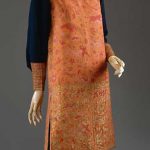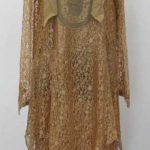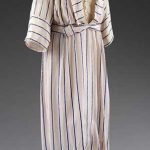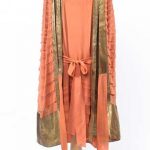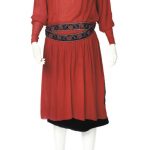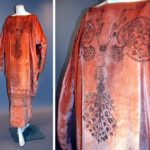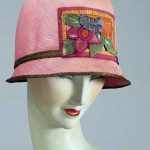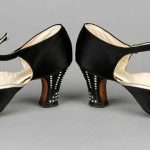Dresses 1920s. During the 1920s day dresses had a drop waist, which was a belt around the low waist or hip and a skirt that hung anywhere from the ankle on up to the knee, never above. Daywear had sleeves (long to mid-bicep) and sometimes sleeveless, and a skirt that was straight, pleated, hank hem, or tiered.
Clothing fashions changed with women’s changing roles in society, particularly with the idea of new fashion. Although society matrons of a certain age continued to wear conservative dresses, the sportswear worn by forward-looking and younger women became the greatest change in post-war fashion. The tubular dresses of the ‘teens had evolved into a similar silhouette that now sported shorter skirts with pleats, gathers, or slits to allow motion. The most memorable fashion trend of the Roaring Twenties was undoubtedly “the flapper” look. The flapper dress was functional and flattened the bust line rather than accentuating it. Wikipedia
Dress ca. 1924 Callot Soeurs French In a reference to Persia, Callot Soeurs created a kind of artistic dress of the 1920s, stark in its tubular silhouette but ornamented on the surface. Despite the presence of decoration, for which they were perhaps best known at the time, Callot Soeurs practiced a disciplined modernism. This day dress with collarless tunic employs a vestigially Ottoman angled sleeve with narrow cuffs.
Reference: The Metropolitan Museum of Art
Dress, chiffon/ lace, Australia, 1920-1930 Made in Australia, Oceania, 1920-1930. Dress, chiffon/ lace, Australia, 1920-1930 Dress of coffee lace with long sleeves, the front in coffee chiffon with deep revers and matching collar, the hem and cuffs edged in coffee lace rouleaux.
Reference: Museum of Applied Art and Sciences
Summer dress of pink silk with narrow vertical blue satin stripes. Mid-calf length with a medium low waist. The bodice is loosely cut with a wide turn down collar reaching to the waist and open to show a tucked organdie vest fastening with snap fasteners. This is attached to the white silk bodice lining. The sleeves are full length, wide and loose with stitched cuffs of self material used transversely. The skirt is straight, and slightly gathered at the waist where there is a draped belt of self material.
This silk summer day dress is part of a collection of well over 100 pieces of clothing worn by Miss Heather Firbank and donated to the museum in 1960. The collection dates from 1905 to the early 1920s and provides a unique snapshot of a wealthy woman’s wardrobe of this time. In contrast to many of the earlier Edwardian garments, with their intricate fastenings and tight fit, this dress demonstrates the straighter less complicated style of 1920s dresses. The bodice is loosely cut with medium low waistband which sits at the hips. The straight-cut skirt and loose sleeves allow for greater freedom of movement. The organdie vest is not a separate garment but is built into the main body of the dress. Even the small mother of pearl buttons which run down the front of the vest hide more convenient popper fastenings.
Reference: © Victoria and Albert Museum
A late 1920s Lucien Lelong dress and cape A salmon pink silk chiffon dropped waisted dress, the skirt with graduated pleating, the neckline trimmed with gold lamé, with a silk underdress; together with a matching cape also with graduated pleating and trimmed with wide lamé bands down the centre front and around the hem, with the post-1926 label ‘Lucien Lelong, 16 Rue Matignon, Paris, Modèle Déposé, Made in France’. (2)
Sold for £ 864 inc. premium at Bonham’s in 2011
JEAN PATOU, A RUSSIAN-STYLE DRESS, EARLY 1920s a rare and dramatic dress, with a fire-red silk crepe Russian style tunic over black silk velvet skirts, the full sleeves tapering to narrow wrists, labelled, the label also stamped ‘JTH150’
Sold for GBP 2,750 at Christie’s in 2007
Fortuny Peach Velvet Cocoon Dress Italian, 1920s With tight doman sleeves, skirt tapering to ankles, gold stenciled Persian tree of life pattern, no label. Fragile condition, tears at shoulders. The dress was originally owned by Dorothy Gish and was given to Miss Worth by Lillian Gish. The lot is accompanied by the February, 1996 issue of American Theatre, where a photograph of Miss Worth wearing the dress in her role as Edith Wharton appears on the cover.
Sold for $5,078 (includes buyer’s premium) at Doyle New York in 2002
[geolocator_show for=”GB”][ebayfeedsforwordpress feed=”http://rest.ebay.com/epn/v1/find/item.rss?keyword=1920s&categoryId1=175784&sortOrder=BestMatch&programid=15&campaignid=5338620288&toolid=10039&customid=pastimefashions-rss-uk-dresses-1920s&minPrice=100.0&listingType1=All&feedType=rss&lgeo=1″ items=”20″][/geolocator_show]
[geolocator_hide for=”GB”][ebayfeedsforwordpress feed=”http://rest.ebay.com/epn/v1/find/item.rss?keyword=1920s&categoryId1=175784&sortOrder=BestMatch&programid=1&campaignid=5338620289&toolid=10039&customid=pastimefashions-rss-us-dresses-1920s&minPrice=100.0&listingType1=All&feedType=rss&lgeo=1″ items=”20″][/geolocator_hide]
